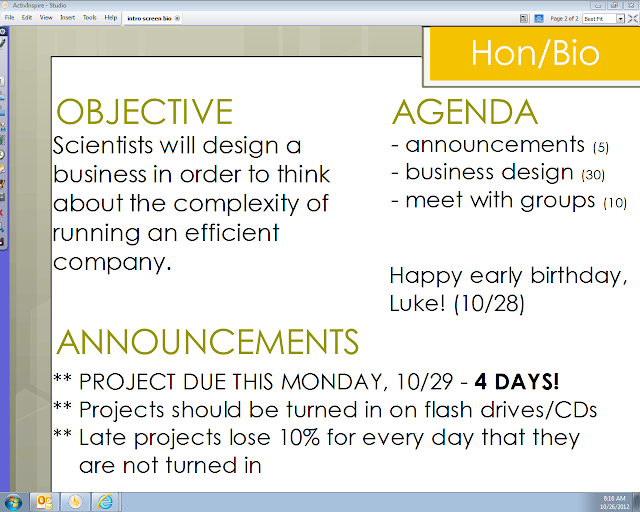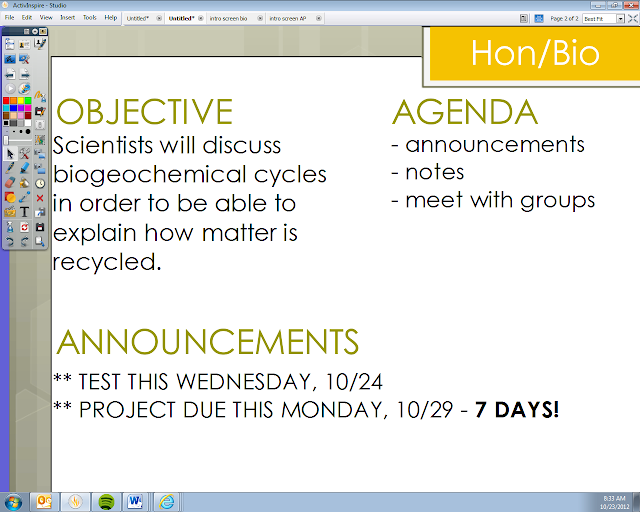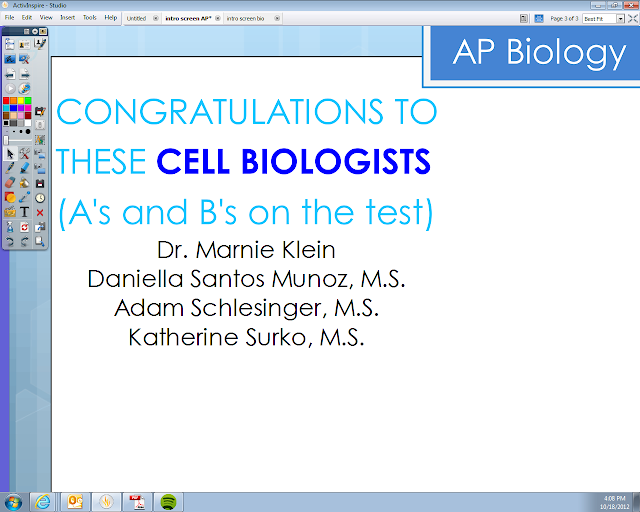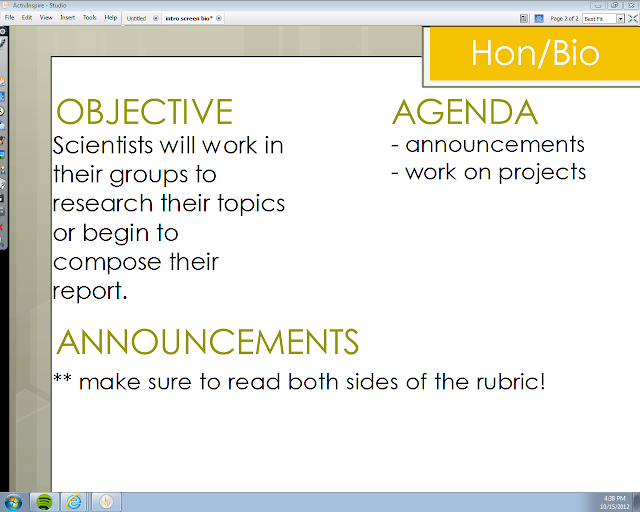Friday, October 26, 2012
Thursday, October 25, 2012
Wednesday, October 24, 2012
Tuesday, October 23, 2012
Monday, October 22, 2012
Thursday, October 18, 2012
Today in AP
Labels:
AP,
EQ's,
essential questions,
indicators,
onion lab,
standard deviation,
statistics,
study groups,
tabs
Today in Biology
**NEW! If you are interested in indicators and essential questions that we have covered in class - meaning that you should know how to answer questions or perform activities related to these topics - click on the "Honors/Biology" tab at the top of the page! Hint: these are great for studying before a quiz or test!
Today in class, we viewed an NBC newscast on the BP oil spill to help students visualize what their newscast should aspire to be. Click below to view it!
Labels:
biology,
cycles,
EQ's,
essential questions,
hw,
indicators,
jigsaw,
newscast,
projects,
tabs
Wednesday, October 17, 2012
Today in Biology
Due to the pPSAT administration today, periods 1 and 4 didn't have class. Period 8 spent the entireity of the period working on their environmental issues project (due in 1 1/2 weeks). No classes will have additional in class time to work directly on their projects. Students should aim to complete their reports by Friday, their newscast scripts (drafts) as soon as possible afterwards, and their filming over the weekend and during the school week. On Saturday, the 27th and Sunday, the 28th, students should put final touches on their newscast and report via editing. Projects are due Monday, the 29th - on a CD or flash drive.
For class tomorrow, students should have read pg. 90-93 in the textbook and answered questions 2 and 4.
For class tomorrow, students should have read pg. 90-93 in the textbook and answered questions 2 and 4.
Tuesday, October 16, 2012
Monday, October 15, 2012
Tuesday, October 9, 2012
AP: Week of 10/8 - 10/12
This week in AP, we begin to study cell communication (powerpoint below) and prepare for our test on Monday 10/15. In class, we also went through each and every question of our Ch. 6/7 Quiz from Friday.
Objective 10/8, 10/9: Scientists will perform the alcohol lab in order to explain how diffusion in a dialysis bag relates to diffusion in a cell.
HW 10/8: work on ch. 11 reading guide
HW 10/9, 10/10, 10/11: work on ch. 11 reading guide, complete alcohol lab write up (notebooks, only) (due Tu 10/16), study for test (M 10/15)
Objective 10/10, 10/11: Scientists will discuss cell communication in order to explain how a signaling molecule can cause various effects within a cell.
Objective 10/12: Scientists will review chapters 6, 7, and 11 in order to properly prepare for our test on Monday, 10/15
HW 10/12: complete and review all reading guides, study for test (M 10/15), and complete alcohol lab write up (notebooks, only) (due Tu 10/16)
Ch. 11 Notes 2012 Ch. 6-7 Review Sheet Key
Objective 10/8, 10/9: Scientists will perform the alcohol lab in order to explain how diffusion in a dialysis bag relates to diffusion in a cell.
HW 10/8: work on ch. 11 reading guide
HW 10/9, 10/10, 10/11: work on ch. 11 reading guide, complete alcohol lab write up (notebooks, only) (due Tu 10/16), study for test (M 10/15)
Objective 10/10, 10/11: Scientists will discuss cell communication in order to explain how a signaling molecule can cause various effects within a cell.
Objective 10/12: Scientists will review chapters 6, 7, and 11 in order to properly prepare for our test on Monday, 10/15
HW 10/12: complete and review all reading guides, study for test (M 10/15), and complete alcohol lab write up (notebooks, only) (due Tu 10/16)
Ch. 11 Notes 2012 Ch. 6-7 Review Sheet Key
bio: Week of 10/8 - 10/12
This week in biology, we'll be continuing our study of ecology. We will start the week by creating food webs and discussing how the presence or lack of a organism in an ecosystem can cause effects that ripple... We will also talk about trophic levels and energy pyramids in order to understand how energy is transferred through an ecosystem. And of course, we will culminate with a quiz on Friday.
Objective 10/8, 10/9: Scientists will construct a food web in order to explain how organisms are connected to one another. (see Torrens River Food Web Activity)
HW 10/8: finish food web Q's
HW 10/9: none
Objective 10/10: Scientists will examine food webs and ecological pyramids in order to explain their usefulness to ecologists and apply those uses themselves. (see Feeding Relationships and Niches Notes)
HW 10/10: none
Objective 10/11: Scientists will perform a predator-prey simulation in order to observe the effects of predator/prey populations on an ecosystem's structure. (see Predator-Prey Simulation)
HW 10/11: finish predator-prey questions, study for quiz (F 10/12)Torrens River Food Web Activity 2012 Feeding Relationships Notes 2012 Niches Notes 2012 Predator-Prey Simulation
Objective 10/8, 10/9: Scientists will construct a food web in order to explain how organisms are connected to one another. (see Torrens River Food Web Activity)
HW 10/8: finish food web Q's
HW 10/9: none
Objective 10/10: Scientists will examine food webs and ecological pyramids in order to explain their usefulness to ecologists and apply those uses themselves. (see Feeding Relationships and Niches Notes)
HW 10/10: none
Objective 10/11: Scientists will perform a predator-prey simulation in order to observe the effects of predator/prey populations on an ecosystem's structure. (see Predator-Prey Simulation)
HW 10/11: finish predator-prey questions, study for quiz (F 10/12)Torrens River Food Web Activity 2012 Feeding Relationships Notes 2012 Niches Notes 2012 Predator-Prey Simulation
Labels:
biology,
biomass,
competition,
ecology,
ecosystem,
energy,
food chain,
food web,
herbivory,
niches,
predation,
pyramids,
quiz,
transfer,
trophic levels
Monday, October 1, 2012
AP: Week of 10/1 - 10/5
This week in AP, we continue to study the amazing, tiny cell!
Objective 10/1: Scientists will identify the functions and structures of cellular organelles in order to began to visualize the the smallest unit of life.
HW 10/1: work on ch. 6 reading guide, complete surface area lab (due tmrw), and work on cell organelle chart (due Weds 10/3)
Objective 10/2: Scientists will identify the functions and structures of cellular organelles in order to began to visualize the the smallest unit of life. (see Ch. 6 Additional Notes)
HW 10/2: work on ch. 6 reading guide and work on cell organelle chart and organelle matching (due Weds 10/3)
Ch. 6 Additional Notes
Cell Organelle Matching Key AP Lab Guidelines 2012
Objective 10/1: Scientists will identify the functions and structures of cellular organelles in order to began to visualize the the smallest unit of life.
HW 10/1: work on ch. 6 reading guide, complete surface area lab (due tmrw), and work on cell organelle chart (due Weds 10/3)
Objective 10/2: Scientists will identify the functions and structures of cellular organelles in order to began to visualize the the smallest unit of life. (see Ch. 6 Additional Notes)
HW 10/2: work on ch. 6 reading guide and work on cell organelle chart and organelle matching (due Weds 10/3)
Ch. 6 Additional Notes
Cell Organelle Matching Key AP Lab Guidelines 2012
bio: Week of 10/1 - 10/5
This week in biology, we'll be diving further into the world of ecology. We will start the week by finishing our viewing of Planet Earth: The Future: Saving Species. The video will link to the introduction of our quarter project: Environmental Issues Investigation.
Objective 10/1: Scientists will finish viewing Planet Earth: Saving Species in order to begin thought and discussion on environmental, ecological issues. (see Environmental Issues Project)
HW 10/1: read Ch. 3-1 and answer questions 1, 2, and 4 (due Tues 10/2)
Objective 10/2: Scientists will create biome posters in order to differentiate between abiotic and biotic factors and discover various biomes of the world. (see Intro to Ecology Notes and Biomes Poster)
HW 10/2: read Ch. 3-2 (pg. 67-73) (due Weds 10/3)
Objective 10/3: Scientists will learn about producers and consumers in order to explain the importance of each to an ecosystem. (see Ecosystem Relationships Notes and Basic Food Chain Summarizer)
HW 10/3: answer questions 1, 4 (pg. 73) (due Thurs 10/4)
Objective 10/4: Scientists will view biome posters created by their classmates in order to understand how abiotic factors affect biotic factors. (see Biome Gallery Walk)
HW 10/4: study for quiz (due Fri 10/5)
10/1 Intro Screen

Environmental Issues Project 2012
10/2 Intro Screen

Intro to Ecology Notes 2012
Biomes Poster 2012
10/3 Intro Screen
Ecosystem Relationships Notes 2012 Basic Food Chain Summarizer 2012
10/4 Intro Screen
Biome Gallery Walk Sheet
Objective 10/1: Scientists will finish viewing Planet Earth: Saving Species in order to begin thought and discussion on environmental, ecological issues. (see Environmental Issues Project)
HW 10/1: read Ch. 3-1 and answer questions 1, 2, and 4 (due Tues 10/2)
Objective 10/2: Scientists will create biome posters in order to differentiate between abiotic and biotic factors and discover various biomes of the world. (see Intro to Ecology Notes and Biomes Poster)
HW 10/2: read Ch. 3-2 (pg. 67-73) (due Weds 10/3)
Objective 10/3: Scientists will learn about producers and consumers in order to explain the importance of each to an ecosystem. (see Ecosystem Relationships Notes and Basic Food Chain Summarizer)
HW 10/3: answer questions 1, 4 (pg. 73) (due Thurs 10/4)
Objective 10/4: Scientists will view biome posters created by their classmates in order to understand how abiotic factors affect biotic factors. (see Biome Gallery Walk)
HW 10/4: study for quiz (due Fri 10/5)
10/1 Intro Screen

Environmental Issues Project 2012
10/2 Intro Screen

Intro to Ecology Notes 2012
Biomes Poster 2012
10/3 Intro Screen
Ecosystem Relationships Notes 2012 Basic Food Chain Summarizer 2012
10/4 Intro Screen
Biome Gallery Walk Sheet
Subscribe to:
Comments (Atom)







































